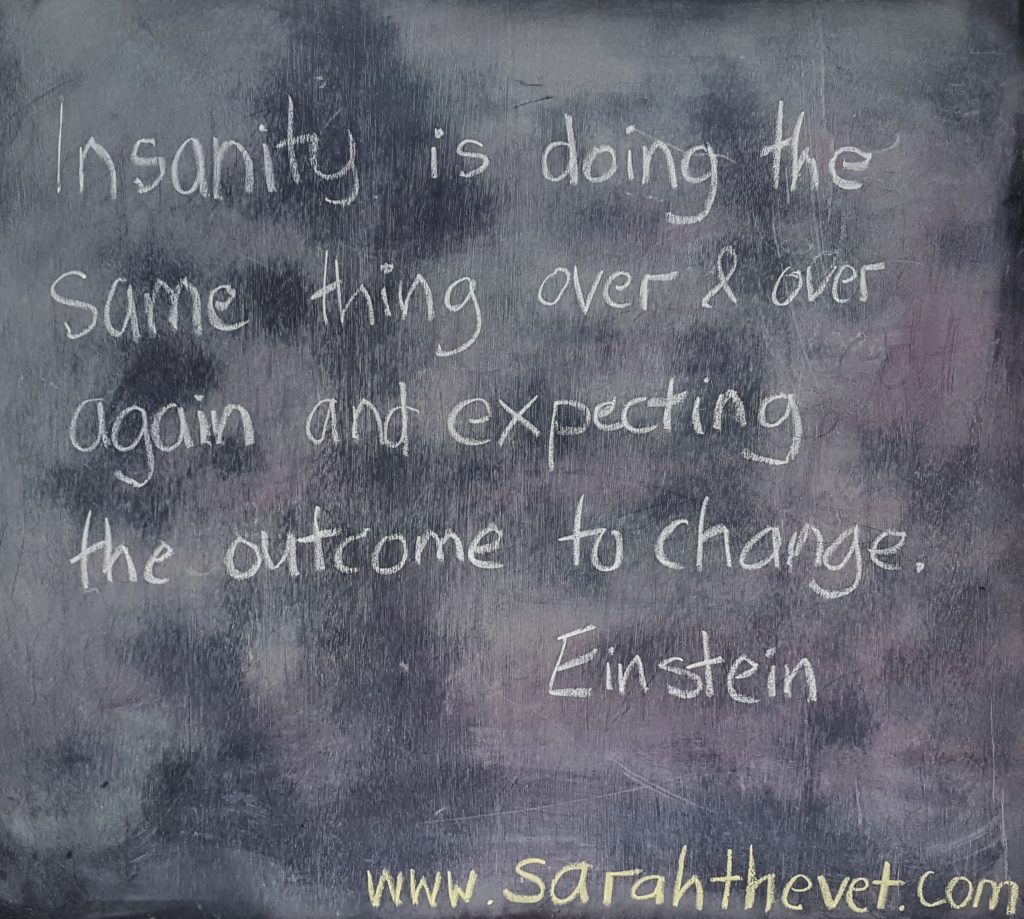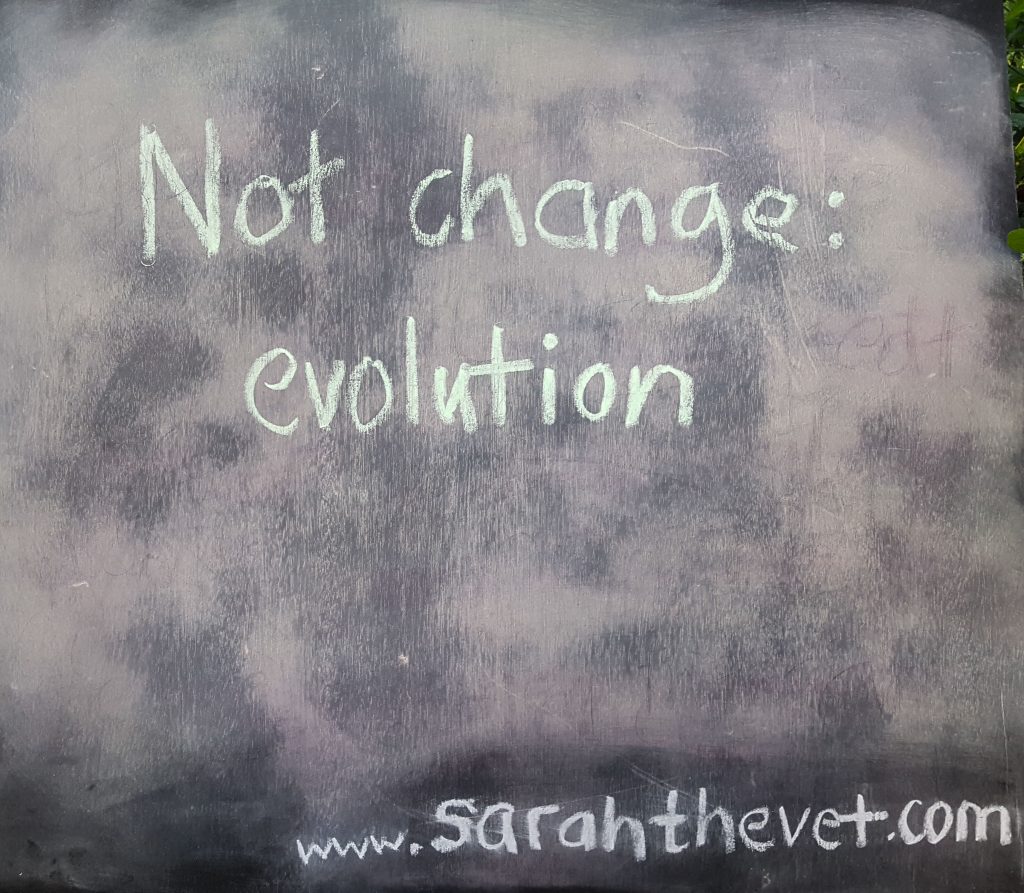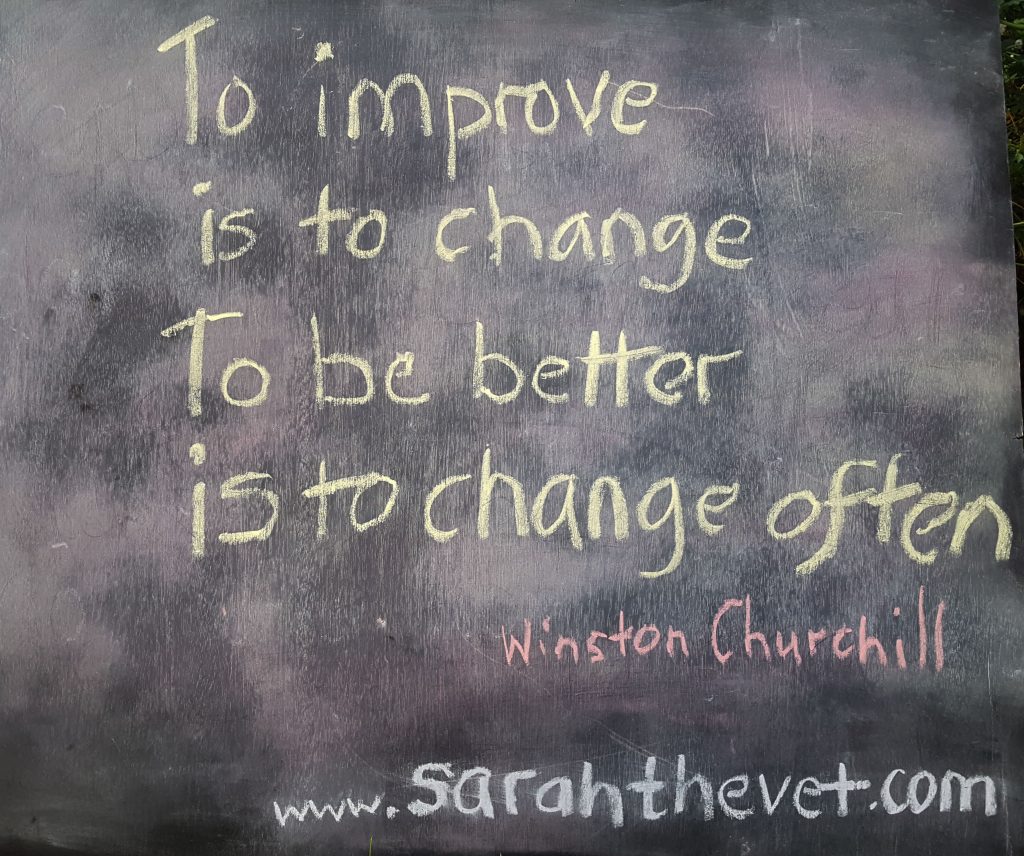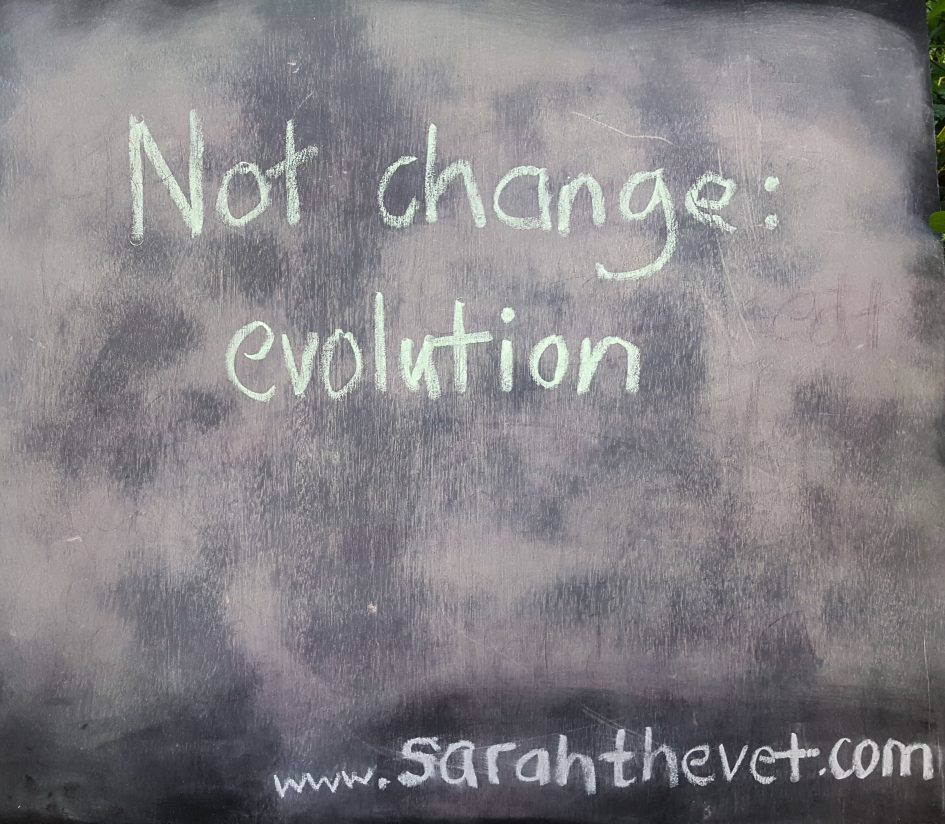At the recent London Vet Show, it was clear there is an overwhelming negativity in the profession regarding recruitment and retainment in particular, and that somehow because of this the profession is broken. How did we get here? What can we do? The current workforce crisis has to be a wakeup call to the profession that we cannot keep doing what we have been doing in the preceding decades. We can’t look backwards; that is not the way we are going.

There will be no quick fixes or easy answers for the problems in the profession. What it will take is solution-based thinking, time, and experimentation. There needs to be wide-spread cultural change; it will be hard, even painful. It will take business owners to be courageous and try something new. There is going to be a painful period of readjustment coming. I’m not claiming to have the answers but let’s start discussions on how we might achieve a brighter future rather than moaning about how we got in this hole.
This is not change, this is evolution.

Why are we in this perfect storm of recruitment and retention?
Since my last article on recruitment and retention (‘Where are all the vets? A perfect storm?’), it has been increasingly obvious that there is a significant shortfall in the available vets’ and vet nurses’ clinical working hours – the RCVS is even holding a summit with key stake-holders to discuss this. Basically there are not enough vets and nurses and too much work – the obvious factors have been the increase in pet ownership and pet owners’ increased requirements for pet care over the past decade, and the dramatic decrease in EU vets coming to work in the UK now when until 2020 half the annual registrations for the past decade have been made up of that group. Brexit stopped the tap of the supply of vets that were plugging the chronic workforce shortage drains that have been building for decades.
What has been underestimated until recently has been what has been termed ‘the great workforce reckoning’, sped up by the COVID pandemic but which was underway before it. This reckoning is that people in the profession and indeed in many areas of work globally are reassessing work in the context of their life, career and aspirations, and taking the opportunity to recalibrate how they balance these, deciding they don’t like the old assumptions and ways of working. They now work to live, not live to work.
There has been wholescale societal, cultural and business change in the past few decades and yet, with the exception of corporate ownership, very little has changed in the veterinary profession. If you took a small veterinary practice from 2021 and took it back through time 30, 40 or even 50 years then apart from the vet assistants being female not male, no-one would bat an eyelid. The profession just has not kept up with these massive societal and business changes – the consolidation of businesses, targeted service provision, internet and virtual provisions, improved employee benefits packages, and most recently a certain level of free service for customers (try before you buy, basic levels free, etc.). After all, the majority of veterinary practices still take the majority of their bookings by telephone!
There are so many factors causing the recruitment crisis and my previous article goes into more depth. It basically boils down to:
- Veterinary practices not providing jobs that modern working people want or are able to do due to not responding to the changing expectations and requirements of the people working in it. Things such as inflexibility with hours; relatively poor salary for the hours worked and stress level of the job; not supporting those that take maternity leave or who have caring roles through poor maternity pay and inflexibility when returning to work; barely tolerable working conditions and doing the bare minimum legally are sadly the standard. I could go on, but you know what these are.
- Increasing levels of dissatisfaction with the profession and where it is headed, and more visibility with social media, including options for alternative career paths which provide those things that the veterinary industry currently doesn’t offer such as career progression. In the UK veterinary profession in 2020 39% were unhappy with their job and looking at leaving the profession, only 53% are satisfied with their jobs currently. This is dire.
- The link between effort and rewards is broken. Salary is becoming relatively less as it stagnates while living costs increase and student debt spirals.
There are many holes in the leaky bucket of the veterinary workforce and at this time we don’t know their relative size and significance – until this has been elucidated, there is little point spending time, effort and money on fixes as we may end up fixing holes that were inconsequential and missing the crucial ones. Ultimately, we must stop myths such as “50% vets leave by 5 years graduation” (which I heard frequently repeated at the London Vet Show even by those that should know better) – this is simply not true and by perpetuating this myth we may inadvertently cause it to become reality.
We also must listen to the workforce; the ones who have left, the ones who are thinking of leaving and, most importantly, the ones that stay – why have they made the decisions they have? Be curious and be prepared to listen to some potentially unwelcome home truths.
What won’t work
It makes sense to think of possibilities that won’t work and why they won’t work before thinking about what could work.
For the foreseeable future, the new normal will become practices functioning with fewer clinical staff and fewer clinical hours of work available. A certain amount can be achieved through improved efficiency, in particular using nurses and non-clinical staff better, out-sourcing jobs and working smarter not harder, but this is not sustainable long term, especially for a growth industry. There needs to be a bigger rethink in the profession about how to provide the services our customers need and expect, balanced with the needs and wants of the workforce. Client lists should be restricted to the numbers that can be safety serviced by the available staff; depending on the business model this is between 800-1500 active clients per FTE vet. Consolidation of clinics needs to happen; there are too many one or two vet branch surgeries, often with multiple in a small town. This is inefficient. Having CT scanners or even a £25,000 ultrasound machine in every practice is not efficient. There is currently a lack of sharing of resources between clinics, especially independents, as each is seen by others as the enemy rather than colleagues. Inefficiencies mean more staff needed and more costs passed to the clients that are increasingly finding themselves priced out of veterinary access.
However, we must take care that short-term sticking plasters don’t become the easy solution at the cost of the long-term changes that are desperately needed.
Some in the industry believe they can tempt European vets to come to work in the UK as was standard in the previous decade. If employers are willing to fully sponsor visas and be flexible with schedules and holiday that allow such staff to return home in blocks of time, then some European vets could be encouraged to work in the UK. I feel, however, we are unlikely to see the numbers that once came to the UK to work and settle. Not least because the pay and work in their countries has improved but the post-Brexit negativity and part of the workforce reckoning increasing the desire to live and so work nearer to family and friends. This also begs the question, if they’re willing to go that far to tempt other nationals to come to the UK, why is it so hard to get them to provide better conditions to keep the staff they already have?
I also believe it is a fallacy to try to encourage those who have left clinical work, the profession or moved into alternative working like telehealth or locuming back into permanent clinical work, whether through ‘incentivisation’ (where the incentives are very much less then they can earn outside the profession) or even guilt-tripping them. Many of those who have changed their work have moved to something better (flexible working, salary, support, etc) so what on earth does the profession believe it can offer to these people to encourage them to leave their improved lives and return to clinical work? Many of the staff that have the left the profession are suffering from forms of complex PTSD and see their previous jobs in the profession as an abusive relationship they survived and fled – how could you ever encourage these people to go back to the profession? Would that even be ethical? And then the RCVS requires full fees for the year no matter how little someone might be working, plus the onerous full CPD requirements.
Perhaps we should consider changing how vets are chosen at the application to vet school stage. It is right to look into how to increase the diversity in the profession and looking at reasons why boys don’t apply to vet school in the numbers that they used to. I think the last is false because if the profession is a good place to work then diversity will naturally happen in the genders. Perhaps we should be asking why previous generations blocked women from training to be vets? There is some evidence, deeply buried, that the current gender make up of the profession is just a reflection of the proportions that have always applied to vet schools just without the selection bias of previous decades.
What solutions then?
You might expect me to list some ideas or solutions here that practices could implement, and some of these ideas will follow, but what I ultimately want to argue for is wholescale evolution of the profession. It is clear that the veterinary profession is not working well as it is, it hasn’t been through the huge social, cultural and business changes that have altered the landscape it works in over the past few decades and if we keep doing what we’ve been doing our situation will only get worse. It is still too common to find practices that say they won’t change for change’s sake, or dismissing a new idea that has long since been standard in another industry without even testing it because “they’re not vets, they don’t understand”. And this is why I call for evolution. The basis of evolution is that different businesses will try different solutions and the fittest will survive. We need courageous leadership and curiosity, businesses willing to trial and experiment and listen and encourage diverse ideas. Or we can be like dinosaurs, stay cold blooded as the world changes, and die out.

If an industry doesn’t work for the people in it, eventually it will not work at all and this is where the veterinary profession is headed. What kind of changes would retain talent in the profession? Practices need to offer jobs that more align with what people want to and can work. The profession is crying out for cultural change, leadership and real purpose with skilled leaders instead of managers, cultures that are positive and psychologically safe and a purpose that is beyond fixing animals and making money for an unseen entity. Leadership that motivates people and recognises how to get the best out of people such as career movement, how to give feedback, and how to create trust and safety. Shared purpose is the bedrock of strong businesses and overwhelmingly this is lost in the corporates and corporate-inspired independent practices. Looking to alternative business models like employee ownership will give purpose to those who would have in previous generations bought into partnerships.
And then we can go about creating jobs that people want – truly flexible working that works around professionals’ lives, reducing overall hours especially on emotionally draining tasks. Businesses need to build a positive employee experience and improve working conditions i.e. the day-to-day of how work feels – reducing cognitive load and emotional toil, reducing repetitive and monotonous jobs and the length of intense working blocks such as consulting, provide real breaks, time to see to the administration tasks that invariably build during the working day and week, recharging between shifts. Job crafting that includes growth, progression and entrepreneurship will inspire employees to continue working even when other factors may not be perfect.
We need to look to other industries and countries for ideas, not the current automatic dismissal that anything that is not ‘veterinary’ would never work, just like how for years and even at the start of lockdown telemedicine was derided as a silly idea and fraught with danger and just too difficult. Well, it is popular with clients, especially millennials and younger, and therefore will stay as feature of the profession going forwards as 50% of pet owners are in this demographic. We need to work out how to use it to reduce the workload on clinical staff and to integrate with what the business offers rather than the more disjointed association it has at the moment.
Something like 80% of younger generation vets are women, some will have families or other caring responsibilities and yet the standard day is 9 to 7pm and truly flexible working doesn’t exist in most practices. Does any private veterinary business provide childcare solutions? Wouldn’t that be revolutionary! It can happen! And what about return to work schemes for parents that have been out of clinical practice and possibly lost their confidence. It is possible to increase maternity pay rather than just provide the legal minimum which is the norm, provide flexibility with rotas so working mothers can be there for children at key times of their day by thinking outside the box with scheduling, perhaps providing childcare on big sites, corporates or – maybe – collectives of nearby independents. The alternative if we don’t sort this out is that the vast majority of the profession will not be able to contribute to its future.
We haven’t managed to fix the difficult transition vets undergo from vet school to competent vets and the painful paradoxes this involves. There is some movement in this regard with the recent inception of the veterinary graduate development programme but we are yet to see if this is a real improvement or another tick-box exercise.
The balance of power has shifted in the employee-employer relationship and it is now all about retainment and incentivisation. Business and practices will need to adapt and adjust to the changed workforce market in order keep sufficient workforce. Employees now have the bargaining power and so are stronger in negotiation. Veterinary businesses need to find ways of improving salaries, but also importantly packages – paid overtime, sickness pay that is not zero, maternity pay that is more than the legal minimum. There is no point promoting superficial perks such as pizza Fridays and yoga breaks if employers aren’t willing to pay all workers a living wage – this particularly applies to nurses. These are the things that help employees feel that they will be looked after if they can’t work rather than just squeezed for everything while they are working and abandoned when they can’t. These factors can make the difference between a vet committing or quitting. Investment needs to be in people not buildings and equipment and this means includes investing in leadership not management. Employers also need to realise the increasing importance of the gig culture as people don’t want to be tied to one job for any time, they want flexibility to choose how and where they work.
Veterinary professionals are clamouring for career progression and growth, no wonder there is such a demand for certificates and referral work. The modern workforce doesn’t aspire to be the manager in someone else’s business, they either set up their own business or wish to grow academically. After all, vets and nurses are highly skilled and undergo highly academic training yet find that clinical work is repetitive and mundane, especially in some business models that move the interesting work from the spoke practices to the hub hospital.
Summary
The profession is not broken, it is going through readjustment and now is the time to shape it to be fit for the future. If we improve the satisfaction of veterinary professionals then engagement and productivity will improve, businesses will be able to grow and take advantage of this massive growth time in the industry and less will be wasted in time and money on recruitment and training. By providing flexible working options, many more in the profession are likely to work more hours not less. Really it is a no brainer – these improvements will more than pay for themselves if we believe enough to invest.
But the work must never stop, otherwise we will be here again in the future. Are we brave enough to do what needs to be done? Fortune favours the brave. Businesses that think outside the box, challenge assumptions and paradigms will thrive, the rest will wither or be swallowed. We can’t wait for the RCVS to do something (they legally can’t) and the associations will produce posters until Rome burns to the ground.
Are you brave enough to start the evolution required? What solutions do you see?


29 November 2021 at 4:44 pm
Vets having “other” commitments resulting in fewer hours worked.
Vets having more time of for legitimate reasons.
“Remote” “detached”non-vet managements.
Prolonged consult times meaning fewer clients per hour but the same financial measurements and therefore “production”.
6 December 2021 at 10:47 am
Indeed Anthony, this is the 4 line summary of my article. And…
15 December 2021 at 6:15 pm
Very well discussed as before, Sarah – I did read this before the Summit too, which was very helpful – thank you.
24 February 2022 at 6:36 pm
Good article but missing a huge driver of vet mental health problems- client behaviour. Practices have to get better at firing unpleasant clients and the rcvs has to get better at backing vets in disputes about refusing to treat the pets belonging to abusive clients. We feel that the clients have a noose around our necks and that we have to help them regardless of how we are made to feel. We are daily made feel rubbish about ourselves by clients even after working long hours, perhaps ooh and doing our best. That wears down the best of people.